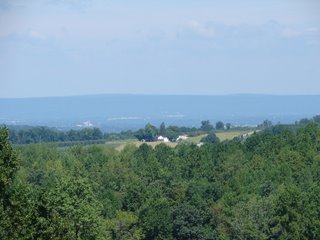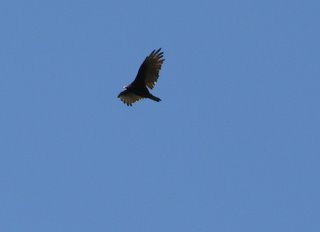 I did a little hawkwatching yesterday, which for those who don’t know, usually entails sitting on a mountain and looking into the sky with binoculars. I guess in some ways it’s a bit like fishing. It’s relaxing but often requires a fair amount of waiting and sitting. On good days it’s like winning the lottery when I see lots of hawks up close or a rare species. On bad days, I hope for good weather and a decent view. And perhaps some good conversation with fellow hawkwatchers.
I did a little hawkwatching yesterday, which for those who don’t know, usually entails sitting on a mountain and looking into the sky with binoculars. I guess in some ways it’s a bit like fishing. It’s relaxing but often requires a fair amount of waiting and sitting. On good days it’s like winning the lottery when I see lots of hawks up close or a rare species. On bad days, I hope for good weather and a decent view. And perhaps some good conversation with fellow hawkwatchers.After being a hawkwatcher for 20+ years, I can pretty much tell which days are going to be productive ones. Unfortunately, telling where the best place to be to see the hawks that fly past is more difficult. That’s why hawkwatching, especially broadwing hawk hawkwatching, is also a bit like gambling. Some hawk species migrate along ridges, but broadwings fly first where the wind takes them and then correct their path to take them where they want to go. So they can show up almost anywhere in this region, and trying to figure out where the wind has placed them is as much art as science, at this point. I “win” just often enough to keep me coming back for more, but I lose a lot too.

Yesterday turned out to be a good day for what is still the early migration season. By Sunday, Hurricane Ernesto cleared the region, and it was one day before more bad weather. That meant birds interested in heading south only had Sunday to do so or wait for the next favorable weather pattern.
As it turned out, I didn’t see as many broad-winged hawks (known as broadwings to hawkwatchers) as I’d hoped. But I did see osprey, sharp-shinned hawks (sharpies) and red-tailed hawks (redtails). I also saw plenty of turkey vultures and a few migrating black vultures. The vultures turned out to be the only ones close enough for photos.
Another enjoyment of hawkwatching is looking at other things that fly by, even when they aren’t hawks. Of these, the best were ruby-throated hummingbird, migrating monarch butterflies, and a first year or female Cape May warbler in the pines below my seat. I also saw small, loose flocks of starlings and grackles that were either migrating or preparing for that by grouping together and flying around.
The big broadwing flight in this area won’t occur for at least another week and more likely not for about 12-13 days. The best variety of hawks, up to 14 species in this area, is coming in mid-October, usually October 20-23. After that hawkwatching requires perseverance and a good wardrobe to brave the cold weather and greet the late season migrants.








4 comments:
Sounds like fun!
Mostly I go to Cape May, but this September I want to get up to the Montclair Hawk Watch (here in NJ) to see the broadwings.
Sounds like a wonderful way to spend some time.
Laura,
Cape May is excellent, especially for falcons. Montclair can be excellent for broadwings, but you just never know. A little east wind and those birds will fly someplace else. Maybe over me!
Carolyn H.
Pablo,
Hawkwatching is fun (and relaxing!). Where else can you sit on a mountain for hours and enjoy whatever you see? If you tried to do the same thing any place else, someone would be sure to find some work for you to do.
Carolyn H.
Post a Comment